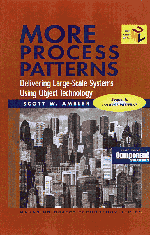Chapter 1 - Introduction to More Process Patterns
Published online by Cambridge University Press: 04 August 2010
Summary
WHEN we left off in Process Patterns (Ambler, 1998b) I had taken you to the point where your software was written. Now in More Process Patterns I'll show you how to deliver, and then maintain and support applications built using object-oriented (OO) technology. Sadly, these are two topics that have been generally overlooked by the object community, until now. There is a lot more to OO development than writing code. There is also a lot more to it than creating use cases, CRC models, and class diagrams. OO development is about creating applications that solve the needs of your users. It's about doing this in such a way that the applications that are built are timely, accurate, and of high quality. This book is about helping you to accomplish these worthy goals.
In this chapter I summarize key concepts presented in Process Patterns. I explore common myths about object-oriented development; describe what process patterns are all about; discuss the object-oriented software process (OOSP) focusing on the serial phases, iterative stages, and the project and cross-project tasks that are vital to the success of your software efforts; and overview the Software Engineering Institute (SEI)'s Capability Maturity Model (CMM).
Exploring Object-Oriented Myths
One thing that you have likely read is that OO development by its very nature is iterative. As you saw in Process Patterns this is only partly true. The main components of OO development—modeling, programming, and testing in the small (formerly known as unit testing)—are in fact performed iteratively.
- Type
- Chapter
- Information
- More Process PatternsDelivering Large-Scale Systems Using Object Technology, pp. 1 - 40Publisher: Cambridge University PressPrint publication year: 1999
- 1
- Cited by

